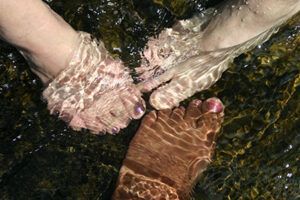Call Us Now! +1 301-589-1066
Diabetic Care, Toenail, Skin Conditions, and Warts
Diabetic Foot Care
How Does Diabetes Mellitus Affect Your Feet?
This disease affects the foot by causing poor immune function, nerve dysfunction (including numbness), circulatory changes, changes in foot posture, and bone anatomy. Changes in skin and nails are often exacerbated in the presence of diabetes. Attention to these problems can help prevent complications, which can impede daily activities.

Peripheral Arterial Disease (PAD)
PAD refers to decreased blood supply that occurs when arterial blood vessels become too narrow. PAD also occurs when the veins do not return blood from the limbs to the circulatory system. Vascular insufficiency largely contributes to the severity of foot infections. Other forms of vascular disease includes venous disease of the veins, and lymphedema, a severe form of swelling.
PAD Warning Signs:
- Night pain
- Cramps while walking
- Changes in skin color and loss of hair
- Thick and brittle toenails
- Cold, pale skin
Neuropathy
Neuropathy can cause altered or lost sensation of pain, temperature, and stability. The patient can underestimate an injury, thus predisposing the foot to breakdown of skin, leading to ulcerations, and infection. Nerve damage can lead to dry cracking skin. Muscle weakness can cause joint and bone deformity.
Ulceration
Diabetic foot ulcerations are among the most challenging foot maladies we treat. When a person’s diabetic state combines with neuropathy and vascular changes, the foot loses the ability to heal. In areas of pressure, the foot can progress to deep and infected gaps in the skin. These are called ulcers, which can expose the bone and cause devastating consequences. We use a variety of wound care and orthopedic management. Our most important tool is prevention.
Toenail Abnormalities & Care
Diabetic Care
- To avoid complications, do not cut your own toenails. Mishaps can occur when individuals with poor vision, nerve damage, and poor circulation attempt self-care.
- Otherwise, you should cut toenails following the shape of your toes, with skin showing at the end. Do not cut into the corners. Do not cut them short.
Common Nail Problems
Ingrown Toenail
A nail plate that is misshapen and grows into the skin of the nail fold.
Fungus in the Toenail
Various discolored, distorted, loosened, and sometimes malodorous nail changes exist. They can become thick and separate from the nail bed.
Frequently Seen Skin Conditions
Fungus in the Toenail
Fungus frequently causes a variety of discolored, distorted, loosened, and sometimes malodorous nail changes. Toenails affected by fungus can become thick and separate from the nail bed. You can confirm its presence by microscopic study. Treatment options will include oral or topical medications as well as attention to sweat and foot gear.
Fungal Infections in the Skin
Also known as Athletes foot. Many types of fungi produce a variety of skin changes, including scaling, splitting, dryness, discoloration, and blistering. If drug-store preparations do not work, seek professional attention.
Corns & Calluses
These result in areas of friction, pressure, and shear. Corns are sites of intense pressure over bony prominences. They will push out outward and cause an accumulation of skin growth, which can be very painful. Calluses result from pressure over a wider surface area than a corn, and you can find them on the soles or heels. They also can be very painful.
Eczema/Dermatitis
The watertight barrier that holds together the outer skin cells becomes weak, and the inner skin loses its ability to protect itself. Irritants, allergens, and microbes can leak past the barrier. This worsens the rash. Commonly it looks red, dry, itchy, swollen, and can be swollen with irritation.
Psoriasis
Very different from eczema, it starts from a complex genetic disease that triggers an immune response to the skin (plus other sites). The extreme overgrowth of the surface skin cells causes the psoriatic areas. The plaques show raised, red, itchy, scaly patches that you can see with silvery scales that can bleed. Psoriasis of the foot can be most challenging and requires vigilant adherence.
Allergies, Sweaty Feet, and Other Conditions
Various allergies affect the feet, such as foot gear, insect bites, or environmental factors. It is common to have sweaty feet at times; some patients suffer from excess sweating called hyperhidrosis. Sweaty feet can also lead to other health issues, such as foot odor, athlete’s foot, and toenail fungus.
Fungus frequently causes a variety of discolored, distorted, loosened, and sometimes malodorous nail changes. Toenails affected by fungus can become thick and separate from the nail bed. You can confirm its presence by microscopic study. Treatment options will include oral or topical medications as well as attention to sweat and foot gear.
Warts
The cause of warts is a form of papillomavirus that invades the skin of the foot. Exposure can occur at swimming pools, showers, hotel rooms – really anywhere people walk barefoot: it can be very challenging. Treatment methods include freezing, cauterizing, topical preparations, and biopsy if necessary.



